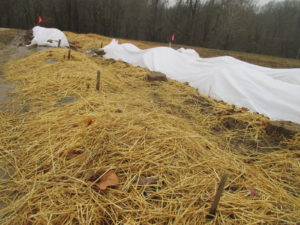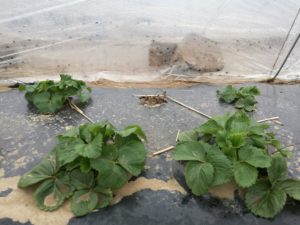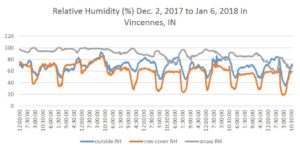Although strawberry plants can be quite cold hardy, they need protection to survive the winter. In North Carolina, growers use floating row covers to protect strawberries in the winter. In Indiana, straw mulch is a more traditional way of winter protection for strawberries grown in a matted row system.
After two relatively mild winters in 2015 and 2016, I heard successful stories about growing strawberries with the plasticulture system and using row covers for winter protection in Southern Indiana. Can the system also be successful in a colder winter, like the one that just passed? Our ongoing strawberry study will provide the answer. This article provides an update from this project comparing strawberries covered with straw mulch (about 4-inch thick) and row covers (two layers of 1.5-oz/yard2 row cover laid on wire hoops) this past winter (Figure 1).
Temperature
Between Dec. 27 to Jan 6, we had the coldest nights of the season in Vincennes, IN. The recorded lowest temperature was around -5°F. The lowest temperatures under row covers were 10°F, while under straw mulch, it was about 15°F. At the dormant stage, strawberries are hardy to 10°F. The plants under row covers encountered the threshold temperature thus we lost 3 out of 192 plants and a few plants were injured. Note the difference of plant growth of the same variety (Figure 2).
Temperature fluctuations were the greatest under row covers. Temperatures under the row covers reached 50°F on sunny days, even when the air temperate was quite cold. Temperature fluctuations were the smallest under straw mulch, and ranged from 15°F to 32°F. The accumulated heat under row covers suggests the plants could potentially come out of dormancy early and be subject to cold damage.
Relative Humidity
Relative humidity was the highest under straw mulch, while lowest under row covers. The high relatively humidity explained why the majority of the leaves were rotted when we removed the straw in the spring. The rotted leaves and the remaining straw provide the perfect condition for the development of Botrytis fruit rot. Compared with the strawberry plants covered with straw, plants under row covers were much cleaner. We removed the dead leaves on these plants, which is a strategy effective in controlling Botrytis.
We will have more updates on the project as the season progresses. Watch for opportunities to see our research at upcoming SWPAC field days.



